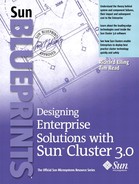Reliability Block Diagram Analysis
Reliability block diagrams (RBDs) are based on a top-down model similar to FTA. However, instead of the result being a failure, the result is a success. The top event is a successful event such as a service being available. The model depicts the successful components and their relationships to achieve top event success. Removal of a block is equivalent to a loss of the success path represented by that block. The focus is on describing all success paths through the system.
The relationships are mapped as serial and parallel connections of the blocks. Redundant components are shown connected in parallel, similar to the AND gate in the FTA. Dependent components are shown connected serially, similar to the OR gate in the FTA. FIGURE D-5 is an example of an RBD for a mirrored disk example. This example is similar to the FTA shown in FIGURE D-1. The model represents components at the FRU level. More detailed models of each of the components can be used if needed. For example, this model shows a single CPU and memory bank, but the model could be extended to show the multiple CPUs and memory banks used in a multiprocessor computer. The decision on what granularity to use for the model is more likely to be based on the information that is available for the components. At a minimum, the mean time between failure (MTBF) should be measured and known. If the mean time to recover and repair (MTTR) is also known, then an RBD can provide an availability figure.
Figure D-5. Mirrored Disk Subsystem Reliability Block Diagram

